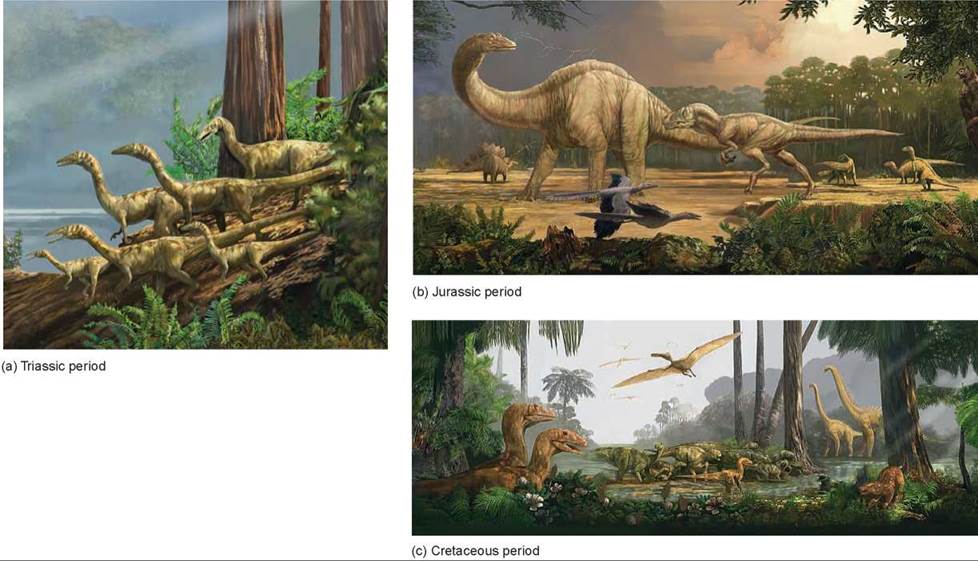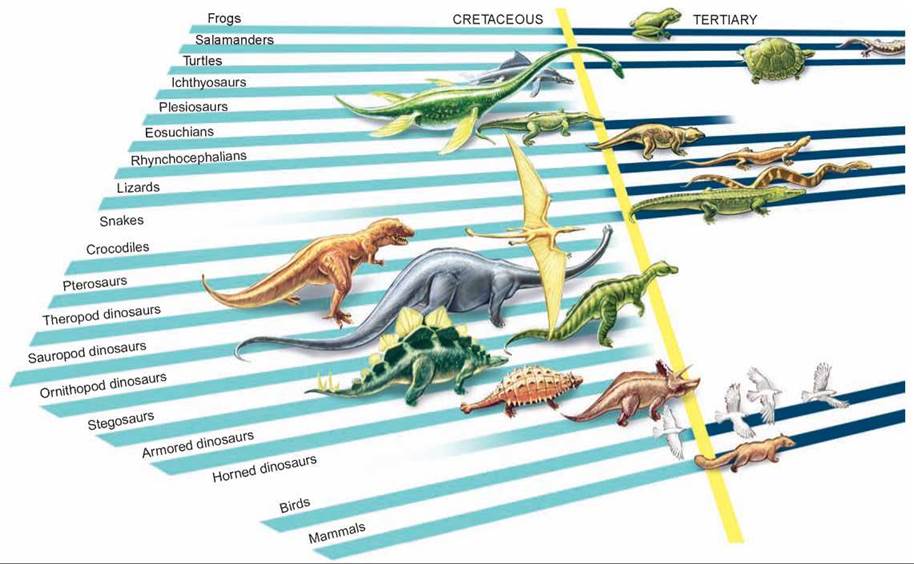THE LIVING WORLD
Unit Five. Evolution of Animal Life
20. History of the Vertebrates
The Mesozoic era (248-65 M.Y.A.) has traditionally been divided into three periods: the Triassic, the Jurassic, and the Cretaceous (see figure 20.1). During the late Triassic period, all the continents were together in a single super-continent called Pangaea. There were few mountain ranges over this enormous stretch of land, the interior of which was arid and dry, with widespread deserts. During the Jurassic, the great super-continent of Pangaea began to break up. Long fingers of ocean began to separate the northern part, called Laurasia (the future continents of North America, Europe, and Asia) from the southern part, called Gondwana (the future continents of South America, Africa, Australia, and Antarctica). The two land masses became fully separated by the end of the Jurassic period. World sea levels began to rise, and much of Laurasia and Gondwana began to be inundated by seawater, forming shallow inland seas. The world climate became even warmer, and because so much of the land was nearer to the oceans, conditions became progressively less arid. During the Cretaceous, both Laurasia and Gondwana fragmented into the continents we now know. Sea levels continued to rise, so that by the mid-Cretaceous, sea levels had reached an alltime high, and the interior of North America was a vast inland sea. Much of the world’s climate was tropical, hot and wet, like a greenhouse. Most importantly, the early Cretaceous saw the first appearance of flowering plants, the angiosperms.
The Mesozoic era was a time of intensive evolution of terrestrial plants and animals. With the success of the reptiles, vertebrates truly came to dominate the surface of the earth. Many kinds of reptiles evolved, from those smaller than a chicken to others even larger than a semitrailer truck. Just the leg of the sauropod pictured in figure 20.5 is over 18 feet tall, indicating a massive animal. Some flew, and others swam. From among reptile ancestors, dinosaurs, birds, and mammals evolved. Although dinosaurs and mammals appear at about the same time in the fossil record, 200 to 220 million years ago, the dinosaurs quickly filled the evolutionary niche for large animals. For over 150 million years, dinosaurs dominated the face of the earth (figure 20.6). Think of it—this time frame is over a million centuries! If you could look back to that distant time and have each century flash by your eye in a brief minute, it would take a thousand days to see it all. During this entire period, most mammals were no larger than a cat. Dinosaurs reached the height of their diversification and dominance of the land during the Jurassic and Cretaceous periods.

Figure 20.5. Some dinosaurs were truly enormous.
Here the paleontologist Jim Jensen is standing by a reconstruction of the leg of a sauropod fossil he found. Sauropods were herbivores that had enormous barrel-shaped bodies with heavy columnlike legs and very long necks and tails. Some weighed 55 tons, stood 10 meters tall, and were over 30 meters long.

Figure 20.6 Dinosaurs.
Dinosaurs, the most successful of all terrestrial vertebrates, dominated life on land for 150 million years. These three images depict scenes during the three periods of the Mesozoic era. Dinosaurs changed greatly during their long evolutionary history from the Triassic period through the Jurassic period and Cretaceous period. These pictures give only a hint of the great diversity of forms seen in the fossil record.
Because of the major extinction that ended the Paleozoic era (see figure 20.1), only 4% of species survived into the Mesozoic. However, as we have described, these survivors gave rise to new species that radiated to form new genera and families. Both on land and in the sea, the number of species of almost all groups of organisms has been climbing steadily for the past 250 million years and is now at an all-time high. This extended recovery from the great Permian extinction had one interruption. About 65 million years ago at the end of the Cretaceous period, dinosaurs disappeared, along with the flying reptiles called pterosaurs, shown as a fossil in figure 20.7, the great marine reptiles, and other animals, such as ammonites. This extinction marks the end of the Mesozoic era. Mammals quickly took their place, becoming in their turn abundant and diverse—as they are today.

Figure 20.7. An extinct flying reptile.
Pterosaurs, such as the fossil pictured here, became extinct with the dinosaurs about 65 million years ago. Flight has evolved three separate times among vertebrates; however, birds and bats are the only representatives still in existence.
What Happened to the Dinosaurs?
Dinosaurs disappeared abruptly from the fossil record 65 million years ago, within a time frame of less than 2 million years. Their extinction marked the end of the Mesozoic era. Figure 20.8 shows the animal groups that survived this mass extinction, which is indicated by the yellow bar; no dinosaurs are to the right side of the yellow bar. Why? Many explanations have been advanced, including volcanoes and infectious disease. The most widely accepted theory assigns the blame to an asteroid that hit the earth at that time. Physicist Luis W. Alvarez and his associates discovered that the usually rare element iridium was abundant in many parts of the world in a thin layer of sediment that marked the end of the Cretaceous period. Iridium is rare on earth but common in meteorites. Alvarez and his colleagues have proposed that if a large meteorite 10 kilometers in diameter struck the surface of the earth 65 million years ago, a dense cloud would have been thrown up. The cloud would have been rich in iridium, and as its particles settled, the iridium would have been incorporated into the layers of sedimentary rock being deposited at the time. By darkening the world, the cloud would have greatly slowed or temporarily halted photosynthesis and driven many kinds of organisms to extinction.

Figure 20.8. Extinction of the dinosaurs.
The dinosaurs became extinct at the end of the Mesozoic era some 65 million years ago (yellow line) in a major extinction event that also eliminated all the great marine reptiles (plesiosaurs and ichthyosaurs) as well as the largest of the primitive land mammals. The birds and smaller mammals survived and went on to occupy the aerial and terrestrial modes of living in the environment left vacant by the dinosaurs. Crocodiles, small lizards, and turtles also survived, but reptiles never again achieved the diversity of the Cretaceous period.
The Alvarez hypothesis has become widely accepted among biologists, although it remains controversial among some. These holdouts argue that it is not certain that dinosaurs became extinct suddenly, as they would have by a meteorite collision, and question whether other kinds of animals and plants show the types of patterns that would have been expected as the result of a meteorite collision. The issue was largely settled in the minds of most scientists when an impact crater was discovered in the sea just off the coast of the Yucatan peninsula. For hundreds of kilometers in all directions are signs of the meteor’s impact, including quartz crystals with shock patterns that could only have been produced by an enormous impact (they are produced, for example, as a by-product of nuclear tests). Large amounts of soot were deposited in rock worldwide at the time of the extinction, indicating very widespread burning. At what date does radiodating place the Yucatan impact? Sixty-five million years ago.
Key Learning Outcome 20.2. The Mesozoic era was the Age of Dinosaurs. They became extinct abruptly 65 million years ago, probably as the result of a meteor impact.